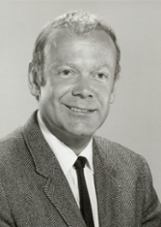
John R. Hetland
Professor of Law, Emeritus
John Robert Hetland was a member of the University of California, Berkeley’s Boalt Hall School of Law (now Berkeley Law) faculty from 1959 to 1991, when he took emeritus status. He died at age 86 on February 16, 2017. He was born on March 12, 1930, raised in Minnesota, attended both undergraduate and law school there, and practiced law in Minneapolis for three years before joining the Berkeley law faculty. His older brother, James, stayed true to his roots and for decades was a faculty member of the University of Minnesota, but John was lured here by that quintessential Minnesotan William Lloyd Prosser, the dean under whose reign Berkeley’s postwar law faculty was built.
John was a lawyers’ lawyer, and not only because his principal areas of interest, secured transactions and property, long were the core of professional practices from the farming village to the metropolis. Perhaps best known for his magisterial knowledge of title insurance in the facilitation of real-estate transfers, John was the author of articles and handbooks on this and related subjects, writing or coauthoring eight books on the financing and securitization of these transactions. While often requested to be an amicus curiae in related litigation, he earned the rare distinction of serving in that role at the direct request of the California Supreme Court itself. As Dean Richard Maxwell at the University of California, Los Angeles, pointed out in his tribute in the issue of the California Law Review dedicated to John on his retirement: “The citation of academic authorities in judicial opinions is common, but the attention paid to Professor Hetland's ideas by the judiciary is of a different quality than the usual reference of this kind. In his frequent role as amicus curiae, his arguments are often treated as though they were coming from one sitting with the court rather than standing before it.”
The subjects John taught, especially the course on “Real Estate Security Transactions,” were popular because of their importance to graduates’ future careers – not because they were easy. Even before John arrived on the faculty, it was a notoriously difficult course. John’s mastery of the subject was the spoonful of sugar that made the medicine go down.
Long of counsel to the title-insurance industry, John chose to reduce his faculty position to 50% when he opened a professional practice in this field in his later years, a firm that his wife, Anne Kneeland, a 1971 Boalt graduate, later joined and that continues to this day. John’s student and longtime partner in that practice, Charles Hansen, captured the deeper basis of John’s professional legacy:
“John's work in the secured transactions area also derives tremendous force from its appeal to the basic human need for system and order… [He] has shown how the California antideficiency and foreclosure statutes contain subtle and reciprocating remedial checks and balances that allow broad latitude to secured creditors in enforcing their rights, while still protecting the legitimate interests of debtors….[L]argely as a result of John's work, California's antideficiency and foreclosure scheme is an elegant clockwork mechanism in which every rule has a reason, every choice a consequence, and every disadvantage a corresponding advantage.
[T]here is still another, almost ineffable, reason for the power and durability of John's work in mortgage law and debtor-creditor relations. The reason is that John's work has captured the spirit of the law at a profound moral level.…John's intellectual and moral roots are in Minnesota, with its unique history of civic-mindedness and farmer-labor-business populism. John's intellectual origins and his personal background—which was not economically privileged—may explain why he has returned again and again to issues of deficiency liability, forfeiture, and the use of disguised security devices….John understands, at a deeper level than many who came of intellectual age after the Great Depression, that one of the roles of law in a free enterprise economy is to ensure that private obligations are vigorously enforced but in a way that mitigates harshness and prevents the grinding down of obligors whose default may be the result of market conditions that, as we have all learned recently, can trip up even the most prudent and industrious businessperson, farmer, or wage earner.”
John married Mildred Woodruff in 1951. After their divorce in 1968, he married Anne Turner Kneeland in 1972. He is survived by his wife Anne; daughters Lynda Catlin and Debra Allen (Robert); step-daughters Robin Willcox and Beth Pickett; grandchildren Kelsey (Harry), Grant, Sandra, Thomas, Barbara, Clark, Reinhold, Alexandra, Kyle, and Reece; great-grandson Renato; and many much-loved nephews and nieces.
Richard M. Buxbaum
2018
